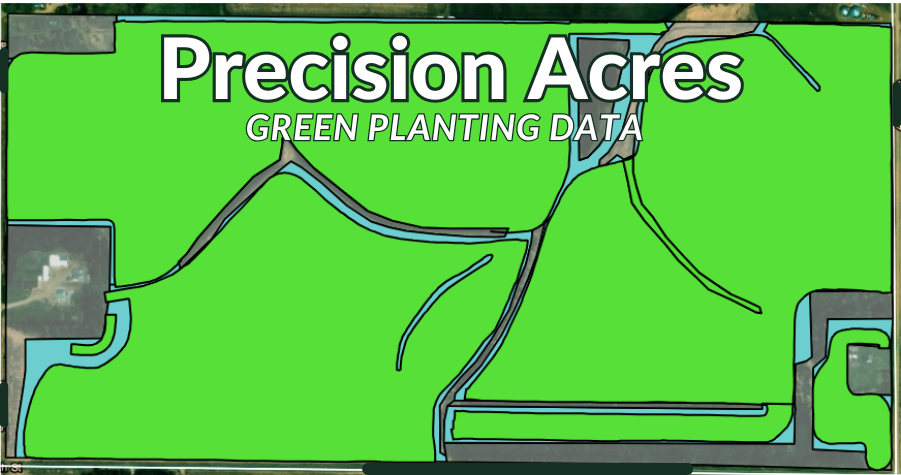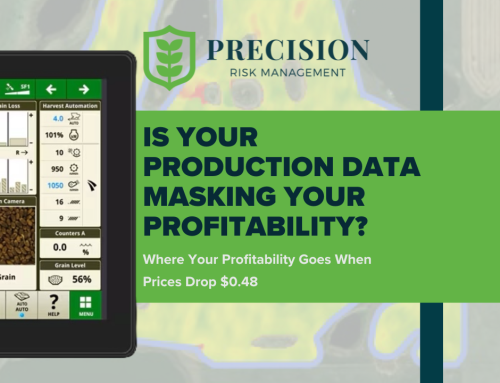Now that you know what CLU acres are, it’s time to look at what comes next: Precision Acres. CLU vs Precision Acres matter, and you need to understand the difference.
CLU maps are the standard for all USDA programs and crop insurance policies. But they do not always show how you actually farm. Precision Acres bridge that gap using GPS data from your equipment to report acreage exactly as it was planted or harvested, not just how it appears on a FSA map.
And when it comes to coverage, claims, and compliance, those differences matter.
CLU Acres: The Traditional Standard
A CLU (Common Land Unit) is the mapped field boundary created and managed by the USDA’s Farm Service Agency (FSA). These maps are used to define acres in all federal farm programs, and your crop insurance policy is built on them.
Why they matter:
- Standardized maps. Everyone — FSA, RMA, PRM, and you — works from the same base.
- Compliance-friendly. Required for program eligibility, including ARC/PLC, CRP, EQIP, and more.
- Insurance accuracy starts here. Your unit structure, planted acres, and eligibility are tied to these field boundaries.
But here’s the catch:
- Maps do not always reflect real-world changes. CLUs only update if you request it at the FSA.
- Reporting errors can happen if you’ve split, reshaped, or changed use of a field but did not update the map.
- Manual process. Updating CLUs means going through the FSA and waiting for approval.
For growers managing thousands of acres, even one mismatch between your CLU and what you planted can cause issues during a claim.
Precision Acres: Your Actual Acres, Digitally Verified
Precision Acres use GPS data logged by your own equipment, like your planter, sprayer, or combine, to report the exact acres you worked. It’s your operation, documented down to the row.
How it works:
- Your field equipment automatically records pass-by-pass data as you plant or harvest.
- That data is exported from platforms like John Deere Operations Center, Climate FieldView, or AgLeader.
- PRM’s Data Team pulls that data int your policy map, matching real-world planting to official field boundaries.
Why this is a major upgrade:
- Accurate to the inch. You get credit for exactly what you farmed, not what someone guessed or mapped ten years ago.
- Time-stamped and verifiable. Ideal for claims or audits, especially when RMA requests supporting documentation.
- Multi-crop fields handled easily. You can have corn and soybeans in the same CLU, and we can report them separately, accurately.
For PRM-insured growers, this means fewer headaches at reporting time, better protection on your policy, and a clean digital record that stands up to any review.
CLU vs Precision Acres: What’s the Difference? You can literally SEE the difference when you look at the maps. In the images below, the blue is the CLU boundaries. The green is the actual planted precision data. All the blue you see is the over-insurance a grower would be paying.


Here’s a side-by-side comparison CLU vs Precision with deeper insight into how each impacts your operation:

Why It Matters for Crop Insurance
Here’s where the difference really shows up. This is about protecting your policy and ensuring your claims are backed by data.
With CLUs alone:
- You could accidentally overreport or underreport acres if your maps do not reflect how you farmed.
- You might miss crop splits, planting date differences, or skips, which could delay or reduce a claim.
- Adjusters may rely only on your CLU if you cannot provide supporting records.
With Precision Acres:
- You have digital, time-stamped proof of what happened in the field.
- You reduce the risk of compliance penalties or gaps in coverage.
- You gain confidence during a loss because you have the data to support your report.
For large-scale operations, this can be the difference between a smooth claim and a major delay.
The Impact on Your Operation: CLU vs Precision
Using Precision Acres doesn’t just help with insurance. It directly improves your daily workload, financial accuracy, and even recordkeeping stress.
1. Faster, Cleaner Reporting
No more measuring by hand or writing on maps. Your data becomes your report. This means:
- Less time gathering info during planting season
- Fewer errors when submitting acres during harvest
- Confidence that what you’re reporting matches what you planted and harvested
2. Smoother Claims
When losses happen, Precision Acres help you get paid faster:
- Claims are easier to verify with exact acres planted
- Data shows what was planted where, and when
- You don’t need to recreate anything from memory
3. Lower Premium Potential
When RMA can verify what you planted, you’re rewarded for precision.
- Lower premium costs by not paying for unplanted acres
- Increased APH Database with your improved yield history
- Fewer corrections or reviews that change previous indemnity payments
For more detail on how Precision Acres can impact your premium, visit our Precision Acres page
How It Impacts Other Farm Programs: CLU vs Precision
Precision Acres are not a replacement for CLUs in USDA programs, but they are a powerful supplement.
Where CLUs are still required:
- ARC/PLC base acre designations
- CRP contract eligibility and compliance
- EQIP and CSP program participation
Where Precision Acres help:
- Proving practice implementation such as cover crops or conservation acres
- Verifying actual crop use on multi-use or transitioning fields
- Supporting documentation during FSA or NRCS audits
For diversified or conservation-focused operations, precision data supports the work you are already doing.
How PRM Makes This Easy
We do not just recommend using Precision Acres, we do most of the work for you!
PRM’s in-house Data Team handles it all:
- Sets-up your precision technology and calibrates your equipment
- Pulls planting and harvest data by field and crop
- Matches that data to your CLU maps
- Prepares your acreage reports to be clean, compliant, and audit-ready
- Flags mismatches early so we can correct them before reporting deadlines
You do the work in the field. We make sure it is reported accurately.
CLU vs Precision Acres Bottom Line
CLU acres are required for crop insurance and USDA programs. You cannot skip them.
Precision Acres are your upgrade. They improve accuracy, make reporting faster, and help protect your operation during claims or audits.
PRM helps you bring both together. If you are ready to simplify acreage reporting and gain confidence in your coverage, reach out to your PRM Advisor or our Data Team today.






